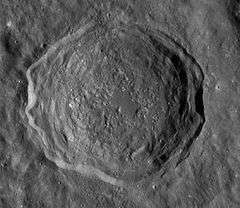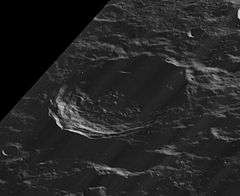Lucretius (crater)
Lucretius is an impact crater on the far side of the Moon. It is located to the southeast of the huge walled plain Hertzsprung, within the outer skirt of ejecta that surrounds that impact feature. To the southwest of Lucretius lies Fridman.
 LRO WAC image | |
| Coordinates | 8.2°S 120.8°W |
|---|---|
| Diameter | 63 km |
| Depth | Unknown |
| Colongitude | 122° at sunrise |
| Eponym | Lucretius |

This crater is a relatively fresh impact, as the formation is well-defined and the rim and interior remain nearly unscathed from impact erosion. The rim has an outward bulge along the western side, so that it is slightly wider in longitude than latitude. The inner walls display some terrace structures, and the interior floor is somewhat uneven in places.
To the northwest of Lucretius is a chain of craters called the Catena Lucretius. These extend for a distance of 271 km across the southern floor of Hertzsprung, and include a number of craters ranging up to 15–20 km in diameter.
Satellite craters
By convention these features are identified on lunar maps by placing the letter on the side of the crater midpoint that is closest to Lucretius.
| Lucretius | Latitude | Longitude | Diameter |
|---|---|---|---|
| C | 3.7° S | 114.4° W | 20 km |
| U | 7.7° S | 123.6° W | 24 km |
References
- Andersson, L. E.; Whitaker, E. A. (1982). NASA Catalogue of Lunar Nomenclature. NASA RP-1097.CS1 maint: ref=harv (link)
- Blue, Jennifer (July 25, 2007). "Gazetteer of Planetary Nomenclature". USGS. Retrieved 2007-08-05.CS1 maint: ref=harv (link)
- Bussey, B.; Spudis, P. (2004). The Clementine Atlas of the Moon. New York: Cambridge University Press. ISBN 978-0-521-81528-4.CS1 maint: ref=harv (link)
- Cocks, Elijah E.; Cocks, Josiah C. (1995). Who's Who on the Moon: A Biographical Dictionary of Lunar Nomenclature. Tudor Publishers. ISBN 978-0-936389-27-1.CS1 maint: ref=harv (link)
- McDowell, Jonathan (July 15, 2007). "Lunar Nomenclature". Jonathan's Space Report. Retrieved 2007-10-24.CS1 maint: ref=harv (link)
- Menzel, D. H.; Minnaert, M.; Levin, B.; Dollfus, A.; Bell, B. (1971). "Report on Lunar Nomenclature by the Working Group of Commission 17 of the IAU". Space Science Reviews. 12 (2): 136–186. Bibcode:1971SSRv...12..136M. doi:10.1007/BF00171763.CS1 maint: ref=harv (link)
- Moore, Patrick (2001). On the Moon. Sterling Publishing Co. ISBN 978-0-304-35469-6.CS1 maint: ref=harv (link)
- Price, Fred W. (1988). The Moon Observer's Handbook. Cambridge University Press. ISBN 978-0-521-33500-3.CS1 maint: ref=harv (link)
- Rükl, Antonín (1990). Atlas of the Moon. Kalmbach Books. ISBN 978-0-913135-17-4.CS1 maint: ref=harv (link)
- Webb, Rev. T. W. (1962). Celestial Objects for Common Telescopes (6th revised ed.). Dover. ISBN 978-0-486-20917-3.CS1 maint: ref=harv (link)
- Whitaker, Ewen A. (1999). Mapping and Naming the Moon. Cambridge University Press. ISBN 978-0-521-62248-6.CS1 maint: ref=harv (link)
- Wlasuk, Peter T. (2000). Observing the Moon. Springer. ISBN 978-1-85233-193-1.CS1 maint: ref=harv (link)